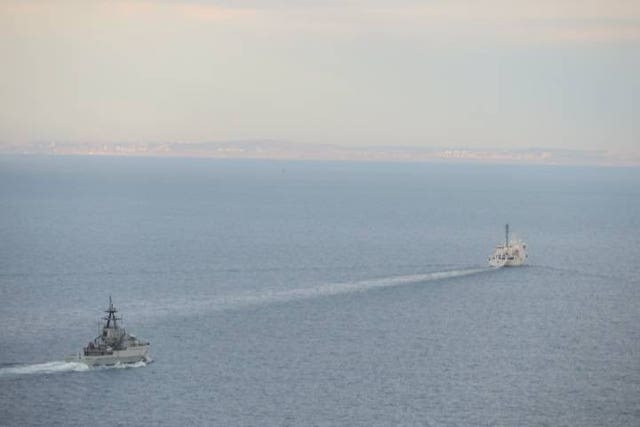Royal Navy Tracks Russian Spy Ship Near UK Waters
The Royal Navy has been closely monitoring a Russian spy ship, the Yantar, after it was detected operating in UK waters this week. Defense Secretary John Healey revealed the incident to Parliament, highlighting the growing concerns regarding Russian aggression and the vulnerability of critical undersea infrastructure.
Russian Spy Ship in UK Waters: A Clear Threat
Healey confirmed that the Yantar, officially classified as an oceanic research vessel by Russia, is primarily used for gathering intelligence and mapping the UK’s critical underwater infrastructure. This includes mapping undersea cables and pipelines crucial for energy supply and internet connectivity. More than 95% of global internet traffic relies on undersea cables, making them a prime target for espionage and potential sabotage. This incident serves as another example of growing Russian aggression, as highlighted by the Defence Secretary.
Healey underscored the significance of the incident with a direct message to President Putin: “We see you. We know what you are doing, and we will not shy away from robust action to protect this country.” This statement underlines the UK’s commitment to safeguarding its national security and its readiness to respond decisively to such threats.
Enhanced Surveillance and Deterrence
The Royal Navy deployed HMS Somerset and HMS Tyne to track the Yantar minute-by-minute during its passage through UK waters. Furthermore, the rules of engagement were adjusted to allow for closer monitoring. A Royal Navy submarine also surfaced near the Yantar, a highly unusual move, purely as a deterrent to emphasize that the vessel’s activities were being closely observed. This unusual manoeuvre was confirmed by the Defence Secretary to be “strictly as a deterrent measure” and was implemented “to make clear that we have been covertly monitoring its every move”. Defence sources also indicated that a verbal warning was issued to the vessel. These measures demonstrate the UK's proactive approach to managing the threat.
A Pattern of Russian Activity
This was not the first instance of the Yantar operating near UK waters. A previous incident in November saw the ship detected “loitering over UK critical undersea infrastructure”. Following that incident, the Yantar eventually departed for the Mediterranean. However, its recent reappearance highlights a concerning pattern of activity. The heightened concern stems from the growing perception that Russia is stepping up such activity since the full-scale invasion of Ukraine.
This heightened activity is not limited to the UK. The incident follows damage to an undersea cable between Estonia and Finland in December, fueling speculation about the potential involvement of Russian ships. This underscores the broader implications of these actions across Europe and the potential for widespread disruption.
Strengthening International Collaboration
The UK is actively collaborating with its NATO allies to enhance its response to Russian naval activity. The Royal Air Force will contribute surveillance aircraft to a NATO deployment aimed at protecting critical infrastructure in the Baltic Sea. This joint effort underscores the collaborative approach to addressing shared security concerns and the importance of NATO partnerships in protecting undersea infrastructure.
The Growing Threat to Undersea Infrastructure
Undersea infrastructure is a crucial component of global connectivity and energy supply. Its vulnerability to disruption or sabotage presents a significant threat to national security and economic stability. The potential damage caused by disrupting undersea cables and pipelines has raised significant concern among Western nations, causing them to increase surveillance operations in the waters around their countries. The UK has stepped up its vigilance, taking steps to counter potential threats to its undersea infrastructure. These steps include the activation of an advanced AI system, Nordic Warden, that will provide real-time threat assessment and alert capabilities.
Response and Future Measures
The UK government has reiterated its commitment to protecting its national security and critical infrastructure. The government is also exploring multiple pathways to protect its interests, with discussions of increasing defense spending to 2.5 percent of GDP, as well as calls to introduce stricter policies with respect to foreign vessels operating in UK waters. While some voices, such as former Defense Secretary Grant Shapps, have called for a more forceful approach including the potential impoundment of suspected spy ships, the government’s current strategy seems focused on heightened surveillance and improved international cooperation.
The incident involving the Yantar serves as a stark reminder of the challenges facing nations in protecting their critical undersea infrastructure in an increasingly complex geopolitical landscape. The response from the Royal Navy demonstrates the UK's commitment to protecting its vital assets and its readiness to counter threats to its national security. This incident should serve as a wake-up call to other nations to reinforce their efforts in safeguarding their own critical undersea infrastructure and engaging in enhanced international cooperation.
The ongoing situation underscores the importance of robust defense strategies and international collaboration in addressing the growing challenges to global security. The future will likely necessitate more sophisticated technologies and a heightened sense of vigilance. The UK’s actions in this instance demonstrate the government's commitment to safeguarding the nation’s critical national infrastructure and security interests. National security remains the government’s top priority. The UK's response to this recent incident shows that it will continue to vigorously defend its national interests.

















